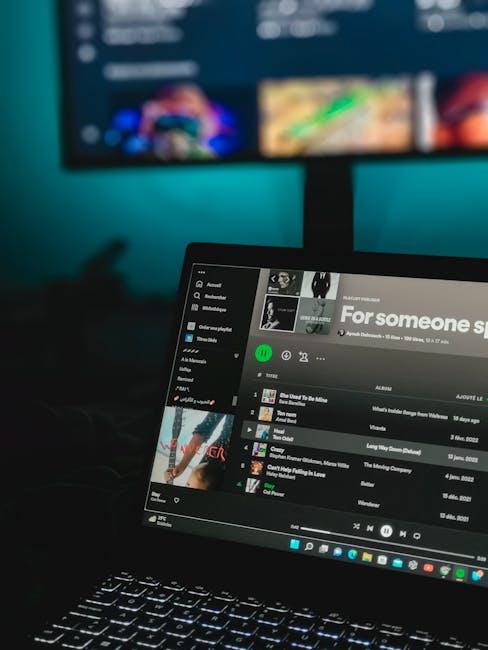In a world brimming with constant noise and ceaseless chatter, sometimes the most powerful soundtrack is the one that quietly fills the space—instrumental and ambient playlists. These curated collections of sound offer more than just background music; they create immersive atmospheres that can sharpen focus, soothe the mind, or simply provide a gentle companion to everyday moments. Whether it’s the delicate piano notes weaving through a morning routine or the ethereal layers of synthesized textures accompanying a late-night work session, instrumental and ambient playlists invite listeners into a subtle sonic journey, where emotion meets tranquility in the absence of words. This article explores the unique appeal of these playlists, revealing how their understated harmonies have carved out a vital niche in our auditory lives.
Table of Contents
- The Soothing Power of Instrumental Music for Focus
- Creating the Perfect Ambient Playlist for Relaxation
- Top Genres That Shine in Instrumental and Ambient Tracks
- How Instrumental Playlists Enhance Creative Workflows
- Curating Soundscapes: Balancing Mood and Tempo
- Essential Platforms and Apps for Discovering Ambient Music
- Q&A
- In Retrospect

The Soothing Power of Instrumental Music for Focus
Instrumental melodies carry a unique ability to dissolve distractions, allowing the mind to glide effortlessly into a state of deep concentration. Unlike lyrics that might engage our inner dialogue, pure instrumental tunes function as a gentle backdrop, fostering an environment where ideas flow uninterrupted. From the calming strains of piano compositions to the subtle rise and fall of string ensembles, these soundscapes invite clarity and productivity. This delicate balance between sound and silence makes instrumental music a prized companion for students, creatives, and professionals alike.
To harness this power effectively, consider curating playlists with varied textures and tempos tailored to specific tasks. Here’s a quick guide to crafting your ideal focus-enhancing mix:
- Ambient pads for seamless, immersive background ambiance.
- Minimalist piano pieces to encourage introspective thought.
- Soft electronic beats that maintain rhythmic momentum without overpowering.
- Acoustic guitar for a warm, organic touch that soothes and grounds.
| Instrumental Type | Best For | Example Artist |
|---|---|---|
| Solo Piano | Deep concentration & reflection | Ludovico Einaudi |
| Ambient Synth | Creative brainstorming | Brian Eno |
| Acoustic Guitar | Light work & relaxation | Andy McKee |

Creating the Perfect Ambient Playlist for Relaxation
Crafting an ideal ambient playlist requires an intimate understanding of how sounds interact with the listener’s environment. The key is to embrace gentle instrumentation that doesn’t dominate the atmosphere but subtly enhances it. Start by selecting tracks with smooth, flowing melodies—think soft synths, ethereal pads, and light piano keys—that create a serene sonic landscape. Incorporate natural sound elements like rainfall, ocean waves, or rustling leaves to anchor the ambiance in a calming reality. Remember, the most effective playlists have a seamless flow, where each track blends effortlessly into the next, allowing the mind to wander without interruption or distraction.
When assembling your playlist, consider the following elements to maintain a perfect balance of relaxation and engagement:
- Pacing: Opt for slow to mid-tempo rhythms that mimic relaxed breathing and heart rates.
- Dynamics: Keep volume variations gentle; sudden loud peaks can disturb tranquility.
- Instrumentation: Favor acoustic or electronic textures that evoke peacefulness without intensity.
- Duration: Create longer tracks or playlists longer than 30 minutes for uninterrupted relaxation.
| Element | Recommended Characteristics |
|---|---|
| Melody | Soft, repetitive, minimalistic |
| Rhythm | Slow, steady, unobtrusive |
| Texture | Warm synths, acoustic instruments |
| Natural Sounds | Water, wind, ambient wildlife |

Top Genres That Shine in Instrumental and Ambient Tracks
Instrumental and ambient music open up a world where melodies and moods blend seamlessly, often transcending traditional genre boundaries. Among the top styles that evoke this ethereal soundscape are Chillout, which embraces soothing rhythms perfect for relaxation or background focus, and Downtempo, characterized by its laid-back beats and lush textures. Post-rock also stands out, weaving intricate guitar work and cinematic progressions that feel both immersive and expansive. Another major player is New Age music, which often incorporates natural sounds and mystical atmospheres to inspire calmness and mindfulness.
These genres share a common thread of crafting immersive auditory experiences, yet each brings its unique flavor. Below is a quick comparison of their distinctive qualities:
| Genre | Key Elements | Typical Usage |
|---|---|---|
| Chillout | Soft beats, smooth synths | Lounges, casual listening |
| Downtempo | Slow rhythms, warm bass | Studying, evening relaxation |
| Post-rock | Instrumental storytelling, dynamics | Film scores, introspection |
| New Age | Ambient textures, nature sounds | Meditation, yoga |

How Instrumental Playlists Enhance Creative Workflows
Instrumental playlists serve as an unobtrusive background soundtrack, helping to cultivate a productive environment without the distraction of lyrics. Their steady, harmonious rhythms can stimulate focus by reducing cognitive overload, allowing creative minds to dive deeper into complex tasks. For many, the subtle ebb and flow of instrumental or ambient music acts like a mental canvas, setting the perfect tone for brainstorming, writing, or designing.
Integrating these playlists into daily workflows offers numerous benefits:
- Enhanced concentration: Eliminates lyrical distractions that interrupt thought processes.
- Mood regulation: Calms the mind, reducing stress and fostering inspiration.
- Consistent pacing: Encourages steady work rhythms, promoting flow states.
| Playlist Type | Ideal Creative Task | Key Benefit |
|---|---|---|
| Minimalist Piano | Writing & Storytelling | Evokes emotion while maintaining clarity |
| Ambient Soundscapes | Design & Visualization | Enhances spatial thinking and imagination |
| Electronic Instrumentals | Coding & Problem Solving | Promotes alertness and cognitive endurance |

Curating Soundscapes: Balancing Mood and Tempo
Creating a harmonious playlist involves more than just stringing tracks together; it requires a careful calibration of mood and tempo that guides the listener on an immersive journey. When selecting pieces, consider how the emotional tone flows from one track to the next—a seamless transition between tempos can sustain engagement without disrupting the ambiance. For example, gently rising tempos can elevate energy levels subtly, while slower tracks invite moments of reflection. Crafting playlists with this balance unlocks the power to transform spaces, making them adaptable to different activities, whether focus-intensive work or tranquil relaxation.
To ensure your playlist remains captivating while respecting the intended atmosphere, aim to incorporate the following elements:
- Variation in dynamics – Shifts in volume and intensity keep the soundscape alive without overwhelming the listener.
- Consistent thematic elements – Use recurring motifs or instruments to create coherence.
- Rhythmic diversity – Blend steady beats with freeform ambient textures for depth.
| Tempo | Mood | Example Track Type |
|---|---|---|
| Slow (40-60 BPM) | Calm, Meditative | Soft piano, airy pads |
| Moderate (60-90 BPM) | Focused, Steady | Minimalist synth, gentle percussion |
| Upbeat (90-120 BPM) | Invigorating, Motivational | Rhythmic ambient, light electronic beats |

Essential Platforms and Apps for Discovering Ambient Music
For those seeking to dive deep into the world of instrumental and ambient music, streaming services have become indispensable. Platforms like Spotify and Apple Music offer expertly curated playlists tailored to every mood and moment. Their algorithms, enhanced by user preferences, continuously recommend new artists and tracks, ensuring that listeners never run dry of fresh, atmospheric soundscapes. In addition, platforms like SoundCloud provide a unique space where independent ambient artists share experimental works, often unavailable on mainstream services, making discovery a truly personal adventure.
Beyond traditional streaming, several apps specialize in ambient sound experiences. Soon, for instance, blends environmental audio with ambient compositions, perfect for relaxation or focus, while Calm app’s music section features artist collaborations that beautifully fuse instrumental melodies with natural sounds. Here’s a glimpse of essential platforms:
| Platform/App | Best For | Unique Feature |
|---|---|---|
| Spotify | Curated Playlists | Algorithmic Recommendations |
| Apple Music | High-Quality Tracks | Exclusive Ambient Releases |
| SoundCloud | Indie & Experimental | Emerging Artist Exposure |
| Soon | Immersive Ambient Experience | Environmental Audio Fusion |
| Calm | Relaxation & Meditation | Artist Collaborations |
Q&A
Q&A: Exploring
Q1: What defines an instrumental playlist?
A: An instrumental playlist is a curated collection of music tracks that typically feature no vocals or lyrics. These playlists focus on the melodies, harmonies, and rhythms produced by instruments alone, allowing listeners to experience the music’s emotional and atmospheric qualities without the distraction of words.
Q2: How is an ambient playlist different from an instrumental playlist?
A: While both playlists often share the absence of vocals, ambient playlists especially emphasize creating a mood or environment. Ambient music is characterized by its soothing, spacious sounds and slow progression, often intended to foster relaxation, meditation, or a contemplative state. Instrumental playlists might include a broader variety of genres and moods, from classical to jazz to electronic.
Q3: Why do people choose instrumental or ambient playlists?
A: Many listeners turn to these playlists to enhance focus, reduce stress, or cultivate a tranquil atmosphere. Instrumental music can aid concentration without the interruption of lyrics, making it popular for studying or working. Ambient playlists are sought after for creating peaceful background soundscapes that help with relaxation, sleep, or mindfulness practices.
Q4: Can instrumental and ambient playlists overlap?
A: Absolutely. Since ambient music is often instrumental, many ambient playlists consist entirely of instrumental tracks. Yet, not all instrumental music is ambient—instrumental can be dynamic, rhythmic, and intense, while ambient typically remains gentle and immersive.
Q5: How do instrumental and ambient playlists influence mental states?
A: These playlists can subtly shift mood and cognitive function. Instrumental music’s balanced structure can enhance creativity and mental clarity, while ambient sounds encourage calmness and reduce sensory overload. Together, they offer powerful tools for emotional regulation and mental wellness.
Q6: Are there particular genres that suit instrumental and ambient playlists?
A: Yes. Instrumental playlists might feature classical, jazz, post-rock, or electronic genres, each bringing distinct textures and energies. Ambient playlists often draw from ambient, drone, chillout, and new age styles, prioritizing minimalism and atmosphere.
Q7: How can one create an effective instrumental or ambient playlist?
A: Start by considering the desired mood and purpose—whether it’s focus, relaxation, or creativity. Select tracks that complement each other in tone and tempo. Aim for a cohesive flow that supports the listening experience, avoiding abrupt changes that could disrupt the playlist’s ambience.
Q8: Where are instrumental and ambient playlists commonly used?
A: They’re popular in a variety of settings, such as workplaces, coffee shops, yoga studios, and therapy sessions. They also enhance personal moments—like study time, meditation, or unwinding in the evening—making them versatile companions for many lifestyles.
This Q&A aims to provide a thoughtful overview of instrumental and ambient playlists, illuminating their characteristics, uses, and emotional impact without bias or embellishment.
In Retrospect
As the final notes gently fade into the background, instrumental and ambient playlists remind us that music need not always demand our full attention to leave a lasting impression. These soundscapes offer a subtle yet powerful presence—serving as both a companion to our daily rhythms and a doorway to moments of quiet reflection. Whether crafting the perfect focus environment or simply unwinding after a busy day, the delicate interplay of melody and mood in these playlists invites us to experience music in its most serene form. In a world often filled with noise, sometimes the most profound soundtrack is the one that speaks softly, and lingers quietly in the air.

